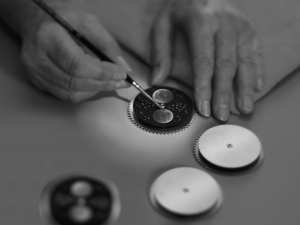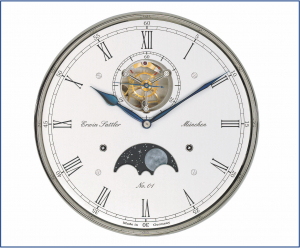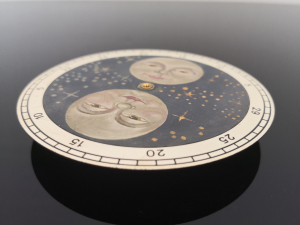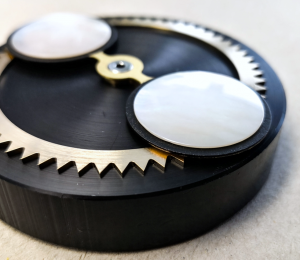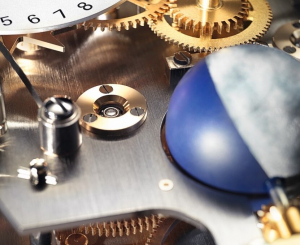Moon phase displays – from new moon to full moon
03. JANUAR 2022
Planning everyday life according to the lunar calendar is normal for some people. They plan their lives according to the current orientation of the moon and follow different approaches to this way of life. For some this sounds like cosmic hocus-pocus, for others it is a clever way of life.
The moon influences many things on our earth that we are probably not aware of. Just one example would be the tides, the difference in height of the oceans of up to 20 metres, between high and low tide. Due to the magnetic attraction of the moon on the water of the earth, in combination with the centrifugal force, a so-called “flood mountain” is created on both, the side of the earth facing the moon and the side away from the moon. Figuratively speaking, the earth rotates under the two ebb valleys in between within a day. Thus the gravitational pull of the moon and the centrifugal force in the earth-moon system interact and cause this effect. The complete system also rotates around a common centre of gravity inside the earth.
The moon also changes its light shape, these are known to us as the different phases of the moon. These phases are caused by the change in perspective of the moon during its orbit relative to the earth. The moon always turns the same side towards the earth, so it rotates once around its own axis during one orbit around the earth. The duration of such an orbit is 29 days, 12 hours, 44 minutes and 2.8 seconds. This phase is also called “lunation”. The different phases of the moon (four different ones, each of which lasts a week in rounded form) consist of a new moon, waxing moon, full moon and waning moon. There are also special events such as the lunar and solar eclipses, which are a much-acclaimed natural spectacle. Besides the low lunar gravity, which makes objects on the moon 6 times lighter than on earth, it is also interesting to note that the temperature on the moon can vary between plus 130 and minus 160 degrees.
The moon phase display is also a special feature of an Erwin Sattler clock, both from a technical and artistic point of view. For generations the talent of oil painting has been passed on in the Sattler family. In former times the father of Viola Sattler (Erwin Sattler’s wife) painted the moons, then Viola Sattler herself.
Nowadays the moons are lovingly handmade directly in the manufactory, painted by Sue Sattler, one of the three daughters of the founder of the company. A clockmaker as profession, drawing and painting have always been one of her greatest hobbies. In the meantime, the phases of the moon are represented in 16 different clockworks in a wide variety of variations. At the time when the clock manufactory was founded, there was only one table clock with integrated moon phase display.
Only lightfast oil colours are used to paint the moon discs and moon balls. Only they guarantee that there will be no loss of colour on the valuable “paintings” over the years.
Of course, the principle “a Sattler clock can be passed on from generation to generation” does not only include the pure mechanics, but also the artistic grace of the various built-in moons. For some models, gold powder is additionally combined with a special lacquer to conjure up the sparkling stars in the night sky.
Due to environmental protection and the ever more important sustainability, some time ago the step from normal oil paints to hydrogen-based oil paints was taken.
There are two moons on each Erwin Sattler moon disc. The technical background for this is the gear wheel that carries the moons, has 59 teeth. It shifts one tooth per day and rotates once around its own axis in 59 days. Thus the moon appears every 29.5 days in the cutout provided for it.
In earlier times all painted moons always had a face, very well fitting to the clocks of that time. Nowadays, however, this is a thing of the past. Matching the modern dials and cases, the moons are delivered without the dreamy looking face.
Finally, selected or limited models show the moon phase with handmade, polished and domed mother-of-pearl discs.
Mother-of-pearl as a noble and also traditional natural product, is ideal for the moon representation! The different incidences of light and the uneven structure create an enchanting shimmer that perfectly simulates the real moon surface.
The processing time of a moon disc is almost two weeks from the production of the raw parts to the ready-to-install moon phase wheel. The painting work for the primer alone takes one day. After painting, the small, round work of art has to dry for over a week.
In addition to the hand-painted moon disc, some models with hand-painted moon ball are also offered and manufactured. The ball made of solid aluminium, which is finely turned in-house, creates a fascinating, three-dimensional effect and thus represents the phases of the moon in a clearly plastic way.


